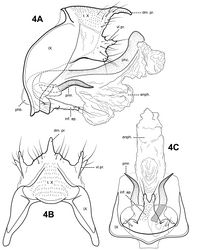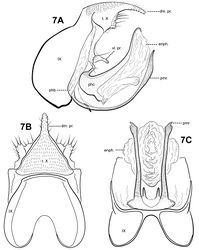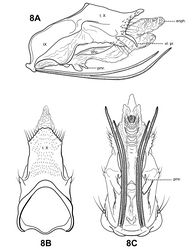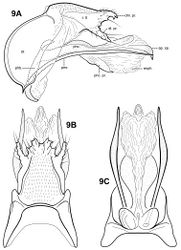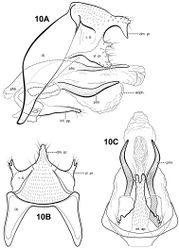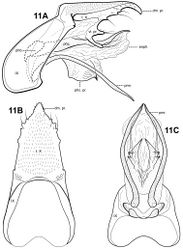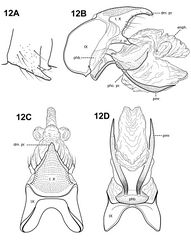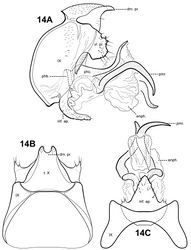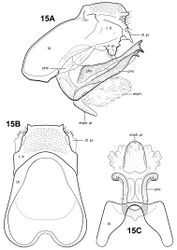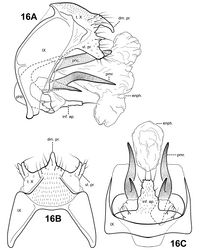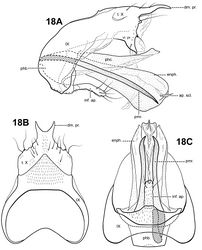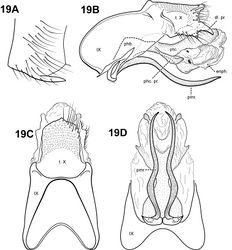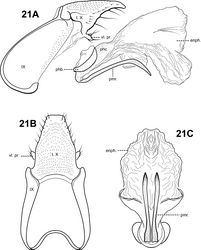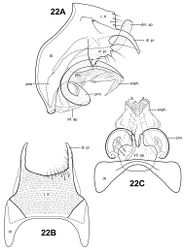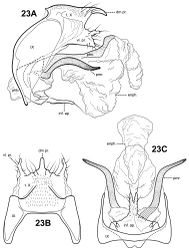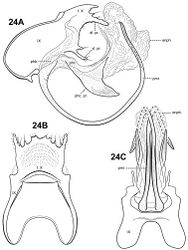| 1 | | | Inferior appendages present as single, sometimes apically bifid, setose process, fused to phallobase ventrobasally (Figs 4–6, 10, 13, 14, 16–18, 22, 23, 25) | | | 2 |
| |
|
| – | | | Inferior appendages absent (Figs 7–9, 11, 12, 15, 19–21, 24) | | | 13 |
| |
|
| 2 | (1) | | Inferior appendage process relatively short and broad (Figs 4C, 6C, 13C, 14C, 16C, 22C, 25C) | | | 3 |
| |
|
| – | | | Inferior appendage process relatively narrow and elongate (Figs 5D, 10C, 17C, 18C, 23C) | | | 9 |
| |
|
| 3 | (2) | | Tergum X dorsolateral margin with paired, very long, finger-like processes; phallicata with elongate dorsomesal spine (Figs 6, 22, 25) | | | 4 |
| |
|
| – | | | Tergum X dorsolateral margin without paired long, finger-like processes; phallicata without dorsomesal spine (Fig. 4, 13, 14, 16) | | | 6 |
| |
|
| 4 | (3) | | Inferior appendage process bifid apically; endophallus without apical sclerites; parameres rather elongate, spiral-shaped, curving nearly 360 degrees (Fig. 22) | | | Itauara spiralis sp. n. |
| |
|
| – | | | Inferior appendage process not bifid; endophallus with apical sclerites; parameres rather broad and tooth-like, not spiral-shaped (Figs 6, 25) | | | 5 |
| |
|
| 5 | (4) | | |
|
| – | | | Parameres not bifid (Fig. 25) | | | Itauara unidentata sp. n. |
| |
|
| 6 | (3) | | Tergum X with elongate, attenuate, downturned dorsomesal process (Figs 4A–B, 13A–B, 16A–B) | | | 7 |
| |
|
| – | | | |
|
| 7 | (6) | | |
|
| – | | | Inferior appendage process not bifid (Figs 13C, 16C) | | | 8 |
| |
|
| 8 | (7) | | Parameres extremely sinuous, not forked; endophallus with large, bifid apical processes; tergum X ventrolateral margin with small, subtriangular setose process (Fig. 13) | | | Itauara guyanensis sp. n. |
| |
|
| – | | | Parameres forked, not sinuous; endophallus entirely membranous without apical processes or sclerites; tergum X ventrolateral margin with broad, irregular, flange-like setose process (Fig. 16) | | | Itauara lucinda sp. n. |
| |
|
| 9 | (2) | | Tergum X dorsomesal margin divided apicomesally, slightly notched, or with large, prominent bifid process; inferior appendage process not bifid (Figs 5, 17, 18) | | | 10 |
| |
|
| – | | | Tergum X dorsomesal margin not divided apicomesally, bifid, slightly notched, or with large, prominent bifid process; inferior appendage process bifid apically (Figs 10, 23) | | | 12 |
| |
|
| 10 | (9) | | Parameres curving upward or tusk-like; phallicata with elongate, apically bifid, dorsomesal spine (Fig. 5) | | | Itauara amazonica (Flint 1971) |
| |
|
| – | | | Parameres not curving upward or tusk-like; phallicata without dorsomesal spine (Figs 17, 18) | | | 11 |
| |
|
| 11 | (10) | | Parameres spiral-shaped or ram-like, curving nearly 360 degrees; endophallus largely membranous, without apical sclerite (Fig. 17) | | | Itauara ovis sp. n. |
| |
|
| – | | | Parameres nearly straight; endophallus lightly sclerotized, with small apical sclerite (Fig. 18) | | | Itauara peruensis sp. n. |
| |
|
| 12 | (9) | | Tergum X with elongate, attenuate, downturned dorsomesal process (Fig. 23) | | | Itauara stella sp. n. |
| |
|
| – | | | Tergum X with large, blunt, dorsomesal process, elongate in dorsal view, subtriangular in lateral view (Fig. 10) | | | Itauara emilia sp. n. |
| |
|
| 13 | (1) | | Phallicata with paired lateral flanges or processes (Figs 9A, 11A, 12B, 19B, 20B, 24A) | | | 14 |
| |
|
| – | | | Phallicata without paired lateral flanges or processes (Figs 7A, 8A, 15A, 21A) | | | 19 |
| |
|
| 14 | (13) | | Tergum X dorsomesal margin irregular, with several small setose processes (Figs 9B, 24B) | | | 15 |
| |
|
| – | | | Tergum X dorsomesal margin not irregular (Figs 11A–B, 12B–C) | | | 16 |
| |
|
| 15 | (14) | | Parameres curving upward, tusk-like; endophallus without apical processes or sclerites (Fig. 24) | | | Itauara tusci sp. n. |
| |
|
| – | | | Parameres arcuate, curving downward; endophallus with tooth-like apical sclerite (Fig. 9) | | | Itauara charlotta sp. n. |
| |
|
| 16 | (14) | | Tergum X with elongate, attenuate, downturned dorsomesal process (Figs 11A–B, 12B–C) | | | 17 |
| |
|
| – | | | Tergum X without elongate dorsomesal processes (Figs 19B–C, 20B–C) | | | 18 |
| |
|
| 17 | (16) | | Parameres sinuous; phallicata very lightly sclerotized basally, rugous or membranous distally (Fig. 12) | | | Itauara guarani (Angrisano 1993) |
| |
|
| – | | | Parameres arcuate, curving downward; phallicata entirely sclerotized (Fig. 11) | | | Itauara flinti sp. n. |
| |
|
| 18 | (16) | | Parameres curving upward, tusk-like; phallicata strongly curved medially, directed anterodorsally (Fig. 20) | | | Itauara rodmani sp. n. |
| |
|
| – | | | Parameres sinuous; phallicata nearly straight, distal portion slightly upturned (Fig. 19) | | | Itauara plaumanni (Flint 1974) |
| |
|
| 19 | (13) | | Sternum IX bearing 2 pairs of extremely elongate, seta-like processes; parameres vestigial, consisting only of a pair of small, digitate setose lobes arising ventrolaterally from endotheca (Fig. 8) | | | Itauara brasiliana (Mosely 1939) |
| |
|
| – | | | Sternum IX without modification; parameres prominently present (Figs 7, 15, 21) | | | 20 |
| |
|
| 20 | (19) | | Tergum X with elongate, attenuate, slightly downturned dorsomesal process; parameres curving upward, tusk-like (Fig. 7) | | | Itauara blahniki sp. n. |
| |
|
| – | | | Tergum X without elongate dorsomesal processes; parameres not curving upward or tusk-like (Figs 15, 21) | | | 21 |
| |
|
| 21 | (20) | | Tergum X dorsomesal margin blunt; parameres bent basally at nearly 90 degree angle, directed dorsally; phallicata sclerotized, not continuous from phallobase (Fig. 15) | | | Itauara julia sp. n. |
| |
|
| – | | | Tergum X dorsomesal margin roof-like, strongly produced; parameres arcuate, curving downward; phallicata very lightly sclerotized basally, more membranous and rugous distally, continuous from phallobase (Fig. 21) | | | Itauara simplex sp. n. |
| |


